NFTs are digital assets representing artwork, music, in-game items, and videos that prove ownership and authenticity. To buy or sell NFTs, a specific marketplace like OpenSea is required. Unlike fungible tokens, buyers cannot exchange NFTs directly. Buyers can use cryptocurrencies like $MATIC and $ETH as payment methods in the marketplace.
Creating an NFT Marketplace can vary in cost depending on several factors, including the complexity of the platform, desired features and functionalities, development approach, and the expertise of the development team involved.
Types Of NFT Marketplace Platforms
On an NFT marketplace, you can buy and sell various digital assets. The specifics may differ depending on the platform, but you can find collectibles related to sports, games, art, and music. While there is currently a lot of buzz surrounding the art NFT marketplace, a few main types of NFT marketplaces are,
Universal Marketplace
This marketplace offers a diverse range of NFT collections for people to explore. Universal marketplaces appeal to many users since they cater to individuals with varying interests rather than a specific group.
Niche-based marketplaces
Niche-based marketplaces are gaining popularity as they specialize in specific and unique assets, appealing to those with distinct preferences. An excellent illustration of such marketplaces is an NFT art marketplace.
Factors Affecting NFT Marketplace Costs
Several factors can influence the cost of an NFT marketplace; some of the key considerations are,
Features And Functionalities
Suppose you want an NFT marketplace with advanced features like integration with external wallets, auctions, escrow services, royalties, and multi-chain support. In that case, it will cost more than a basic marketplace with features like user registration, NFT creation, listing, buying, selling, and bidding.
Design & User Experience
The design and user interface (UI) are essential for attracting users and ensuring a smooth trading experience. Although custom designs, responsive layouts, and intuitive navigation may increase development costs, they are well worth improving the marketplace’s overall aesthetics and user experience.
Blockchain Platform
The choice of blockchain platform affects development costs. Different platforms like Ethereum, BNB Chain, or Flow have varying levels of complexity, development resources, and associated costs.
Regulatory Compliance
NFT marketplaces must follow different legal and regulatory rules depending on their location. These rules require them to strictly follow AML (Anti-Money Laundering) and KYC (Know Your Customer) regulations, obtain licenses, and maintain data privacy. These requirements can make the process a little complicated and expensive.
Security And Audits
Security is crucial in NFT marketplaces due to the asset value and ownership involved. Conducting security audits, implementing security measures, and ensuring the safety of user wallets, transactions, and smart contracts contribute to the overall development costs.
Team Composition And Expertise
The cost of development is affected by the composition and expertise of the team. Employing talented blockchain developers, UI/UX designers, smart contract auditors, and quality assurance professionals can increase the overall expenses of the project.
Scalability And Infrastructure
To effectively manage the high volume of transactions and user activity, NFT marketplaces may require additional development efforts and infrastructure development to ensure scalability, high performance, and fault tolerance.
How To Create An NFT Marketplace App?
- Define Your App’s Objectives and Target Audience
Determine the purpose of your NFT marketplace app and identify the users you want to cater to. Understand their needs and preferences to tailor your app accordingly. For example, It could be the gaming, sports, luxury, or entertainment industry; This would help you better define your NFT marketplace requirement.
- Design the App Interface
When designing the app for your NFT marketplace, focus on creating intuitive and visually appealing interfaces. Consider a clean and organized layout with easy navigation. Include panels for NFT discovery, user profiles, asset listings, transaction history, and wallet management. Prioritize user experience to enhance engagement and usability.
- Essential Documentation
While developing an NFT marketplace app, it is important to provide thorough documentation. This should include API references, SDKs, integration guides for developers, and user documentation to explain app functionality, features, and troubleshooting. By offering well-documented resources, developers and users will better understand how to use your NFT marketplace app effectively.
- Implement Security Measures
Implementing strong security measures and following best practices can safeguard user data, transactions, and app functionality.
- Test And Refine
Conduct thorough testing to identify and fix bugs or issues: test the app’s functionality, security, and performance to deliver a reliable and user-friendly experience. Collect user feedback and iterate on the app accordingly.
Concluding Thoughts
The cost to create an NFT marketplace app varies depending on features, complexity, platform choice, and development resources. Careful planning, prioritizing features, and engaging a skilled development team are needed to optimize costs and create a successful NFT marketplace app.
If you want to get precise pricing for developing an NFT trading place, you should reach out to NFT marketplace development companies. They can customize a white-label NFT marketplace that fits your specific needs. It’s important to select a vendor that aligns with your requirements.
You may also like
-
Automatic Fruit Wine Bottling Line for Small Wineries: A Complete Guide
-
How Does Plywood HSN Code Decide the GST Rate for Traders and Manufacturers?
-
POS Terminal Type: Which Is Best for Your Business?
-
How to Choose Fixed and Portable Gas Monitors for Industrial Gas Detection?
-
Simplifying Trademark Registration in Hong Kong: What Businesses Need to Know

